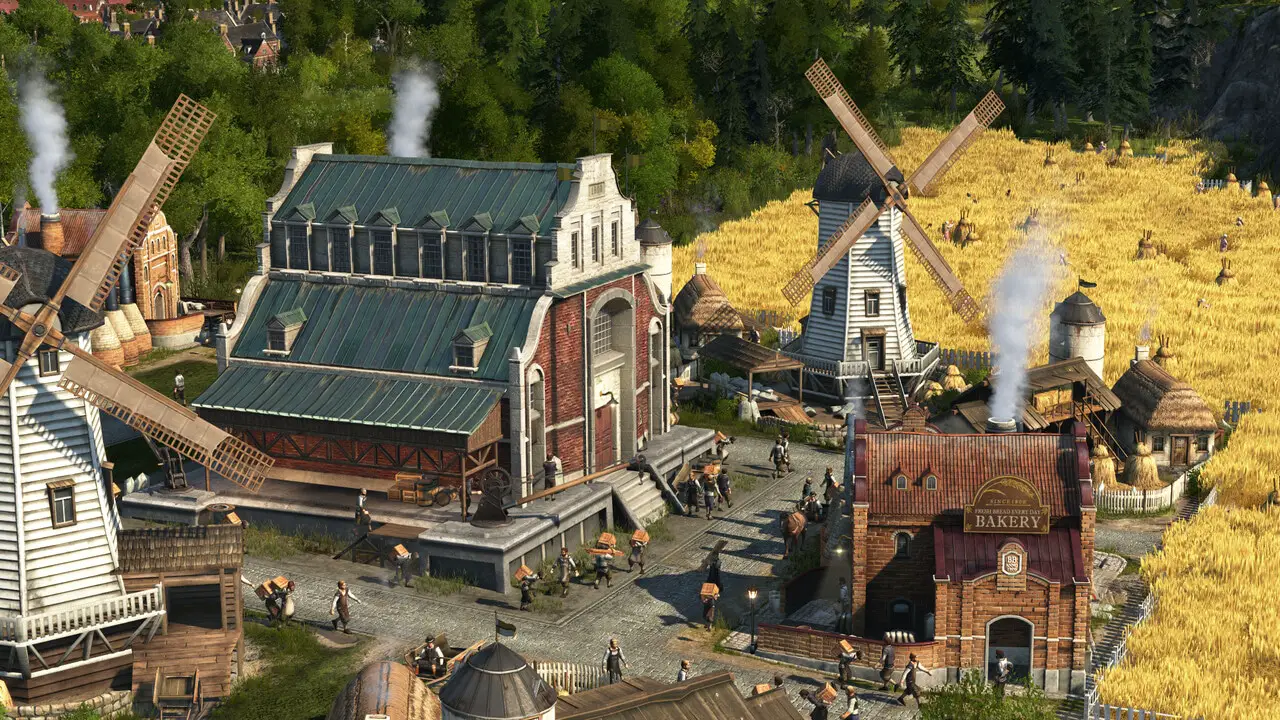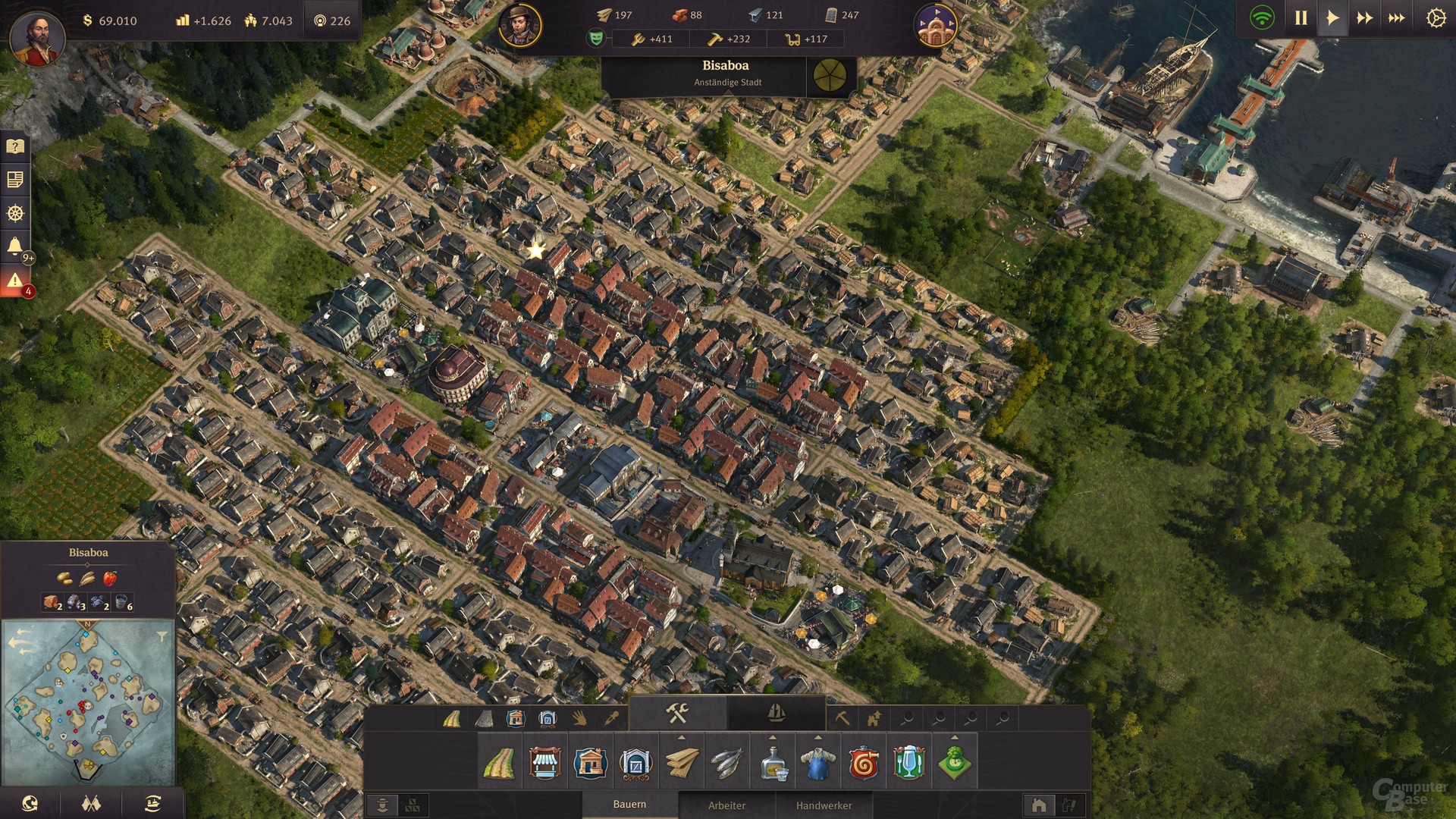– Anno 1800 delivers a graphic firework display. Visually, the game with the many details is a feast for the eyes. However, the benchmark test shows that, despite DirectX 12, a strong processor is required for this, because the CPU limit is low. If you do without the last bit of graphic splendor, you can do with less.
Note: There is now also a community test for Anno 1800, which contains many other benchmarks.
The Anno series has always been known for very good graphics and the Anno 1800, which will be released on April 16, is no exception. Visually, compared to the three and a half year old Anno 2205 (test), a large portion is put on top again. The engine shows an incredible number of lovingly designed details that impress from a bird’s eye view and up close. Every single building is worked out with great attention to detail, all residents are very well animated for a strategy game and credibly reflect what they are doing: whether at work, drinking in a pub, extinguishing fire, parade in the market place or rioting.
Postcard graphics as far as the eye can see
Anno 1800 offers “postcard graphics” throughout and is not only by far the most beautiful strategy game, but also does not have to hide from the big AAA games like Battlefield V, Metro Exodus and The Division 2. Their graphics are completely different in terms of style, but there is something to be astonished in all cases. Responsible for the good optics is the in-house Anno engine developed by Ubisoft and the German studio Blue Byte, which has been upgraded for Anno 1800.
This has not only become prettier, but now also supports DirectX 12 in addition to the classic API DirectX 11. This enables a significantly more detailed display, and also relieves the processor – this is something that Anno 2205 had to struggle with. The technical test clarifies how fast the graphics card must be in addition to the CPU for smooth gaming with good graphics, with numerous benchmarks in the following sections. Other tests should clarify how well Anno 1800 developed with the help of the community itself.
Anno 1800 is not part of any AMD or Nvidia funding program. Accordingly, there are no special graphic effects.
The tests were conducted with a review version of the game, which has already largely included the Day 1 patch. The missing parts should not interfere with the game experience, according to Ubisoft.
For some time now, Ubisoft has been building extremely complex graphics menus on the PC, which can boast numerous graphics options, sample screenshots, special functions and a lot more. The implementation in Anno 1800, on the other hand, is rather simple. There are five different graphics presets and a good number of graphics options, but that’s about it.
Comparison of graphic presets
The five different graphic presets are named “Low”, “Medium”, “High”, “Very High” and “Ultra High”. The latter also represents the sum of the maximum graphic details. The optical differences between “ultra high” and “very high” are subtle, but still easy to see. For example, some trees are missing from “Very high”. However, it is much more striking that many production buildings lack some details. The port area in particular suffers significantly, while other buildings suffer less, but some objects are no longer displayed there either. In contrast, the living area looks comparable.
While the changes for “Very high” are only subtle, the quality for “High” decreases visibly. So significantly more trees are now missing and the rest of the ground is shown with much less different details. Some details are generally lost in the buildings and the shadows are one step higher. In addition, fewer people populate the settlement, making it far less lively.
The middle graphic details turn the same screw as “Hoch”, everything is simply shown less and the textures become blurred. With the low preset, all residents have disappeared and the tree population is even smaller. In addition, the textures look very blurry.
Conclusion: “Very high” can be easily used for better performance. From “high” the losses become clear, so that the setting should be avoided if possible. The two lowest settings leave little of the graphic splendor.
The performance differences of the individual presets are huge. If you switch back from “ultra high” to “very high”, you will get 77 percent more pictures per second on a GeForce RTX 2070, the Radeon RX Vega 64 is even twice as fast. The setting “High” then “only” brings 26 percent more performance, “Medium” makes a huge leap again with 75 (AMD) and 77 (Nvidia) percent. The lowest graphics setting then massively accelerates the game again with an increase of 74 or 53 percent. Or expressed in frames per second: The GeForce RTX 2070 can be accelerated from 36 FPS to 218 FPS, the Radeon RX Vega 64 from 26 FPS to 202 FPS. Such great flexibility is rare.
The presets and anti-aliasing benchmarks were created with a different test scene than the rest of the benchmarks. So the results are not comparable.
Graphics presets in Anno 1800
- Low
- Central Preset
- High-Preset
- Very-high-Preset
- Ultra high-Preset
- Low
- Central Preset
- High-Preset
- Very-high-Preset
- Ultra high-Preset
Anti-aliasing costs a lot of performance, but works well
Anno 1800 is one of the few games that offers classic multisampling anti-aliasing that the Anno engine has been using for some games. The method has its advantages, for example, because the image does not become blurred even in low resolutions. But there are also disadvantages.
The MSAA is offered in 2 ×, 4 × and 8 × levels. 2 × does not smooth out really well, many objects still have to struggle with flickering geometry. A decent job, on the other hand, does four-fold MSAA. Already in 1,920 × 1,080 the picture looks pretty calm. And since it is usually only shifted in the isometric view, the imperfect picture quietness is hardly noticeable when playing. Eightfold MSAA then makes everything a little better, but the advantages compared to level 4 × are only minimal and therefore hardly visible.
Anti-aliasing in Anno 1800
- No anti-aliasing
- 2x MSAA
- 4 × MSAA
- 8xMSAA
- No anti-aliasing
- 2x MSAA
- 4 × MSAA
- 8xMSAA
However, the biggest disadvantage of MSAA is the significant loss in performance. The optically not really good double MSAA costs 16 percent FPS on the Radeon RX Vega 64 and 10 percent on the GeForce RTX 2070. Quadruple MSAA reduces performance by a further 15 or 17 percent. The optically beautiful and therefore sensible fourfold MSAA reduces the performance by 29 percent on an AMD and 25 percent on an Nvidia graphics card – that’s massive. Eightfold MSAA costs a whopping 23 or 16 percent. The anti-aliasing in Anno 1800 takes more power on a Radeon than on a GeForce.
The influence of the bustle factor
Regardless of the selected preset, the “wobble factor” can be configured in the graphics options from low to ultra-high. It determines how many inhabitants are shown on the screen. Adjustments in this setting virtually only change the load on the CPU. This is made clear by the following benchmarks, which were performed on the Core i9-9900K (DDR4-3200) with GeForce RTX 2080 Ti FE.
Impact of performance Wuselfactor
- Low
- medium
- High
- Very high
- ultra-high
- Low
- medium
- High
- Very high
- ultra-high
In the Full HD run, which is already significantly slowed down by the CPU, a good 20 percent FPS can be gained by changing the wobble factor from ultra high to low, provided the GPU is fast enough. In Ultra HD, however, in which the Turing graphics card sets the pace, it doesn’t matter which bustle factor is involved.
On the next page: GPU benchmarks and DirectX comparison
















